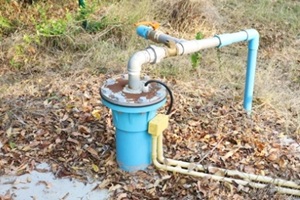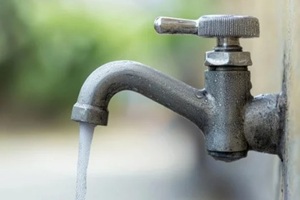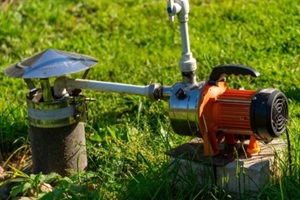
As a homeowner, having a private well equates to control over your household’s water supply, but it also means that the responsibility for testing and treatment rests entirely with you. Unlike municipal systems, wells are not regulated, so the safety and quality of your water depend on the steps you take to protect it.
Clear, great-tasting water can still contain unseen contaminants, such as bacteria, arsenic, or nitrates, that can affect the health of you and your family, your plumbing, and household appliances.
Treatment begins with knowing what’s in your water so that you can properly address it. Different water issues require different strategies, because what works for minerals may not be effective against emerging threats like PFAS.
Why Testing Matters
Private wells operate outside the scope of the Safe Drinking Water Act, which means homeowners are responsible for monitoring and maintaining their water quality. Testing at least once a year is the foundation of an effective treatment plan.
The U.S. Environmental Protection Agency (EPA) suggests scheduling yearly water tests that include total coliform bacteria, nitrates, total dissolved solids (TDS), and pH levels, along with region-specific contaminants that may occur in your local groundwater. Testing should also occur after flooding, well repairs, or whenever taste, color, or odor change.
Common well contaminants include iron, manganese, arsenic, nitrate, radon, uranium, and synthetic chemicals such as pesticides or PFAS. Many water quality problems stem naturally from the composition of local rock and soil, whereas elevated nitrate levels are more commonly linked to human activity, such as fertilizer use or leakage from septic systems.
A certified lab can provide a detailed panel, covering bacteria, nitrate/nitrite, TDS, pH, iron, manganese, hardness, and metals specific to your area. Specialty testing for arsenic, uranium, radon, PFAS, or hydrogen sulfide may be needed based on local conditions.
Retesting yearly and keeping records helps track changes and guide treatment decisions. Test results serve as a roadmap for selecting the right solution.
Choosing Between Point-of-Use and Point-of-Entry
Water treatment devices are designed to handle specific problems and can be installed at a single tap or for the entire home.
Point-of-Use (POU) systems treat water at one faucet, making them ideal for contaminants that are harmful when swallowed, such as arsenic and nitrate. A POU system may include reverse osmosis (RO) or specialty filters for drinking and cooking water.
Point-of-Entry (POE) systems, often called whole-house units, treat all water entering the home and are used for contaminants that affect bathing, air quality, or plumbing. A POE setup can feature softeners, UV disinfection, or iron removal systems to protect fixtures, appliances, and air quality.
Selecting the right location for water treatment depends on how exposure occurs. For example, radon can be released into indoor air during showering, so a POE aeration system is preferred, while arsenic is handled with POU filtration for drinking water.
Matching Contaminants to Treatment Solutions

Effective water treatment depends on identifying what’s in your water and choosing solutions built to address each concern. Matching the right technology to the issue creates reliable results and safer water throughout your home.
Microbial Contamination
Ultraviolet (UV) disinfection certified to NSF/ANSI 55 Class A is a reliable method for inactivating bacteria, viruses, and parasites such as Giardia and Cryptosporidium. Clear water is essential for proper UV function, so sediment and iron filtration should come first.
Continuous chlorination with a contact tank and carbon polishing is another option when residual protection is desired or if biofilm buildup is a concern.
Nitrate
Anion exchange or POU reverse osmosis effectively reduces nitrate levels. Boiling should be avoided, since it concentrates nitrate rather than removing it. If nitrate exceeds safe limits, bottled or alternate water should be used for infant formula until treatment is verified.
Arsenic
Adsorptive media such as activated alumina or iron-based filters at the tap are effective choices. Based on laboratory results and the composition of your water, systems such as reverse osmosis and anion exchange can be selected to address targeted concerns effectively. Whole-house treatment is often unnecessary because arsenic is not absorbed through the skin.
PFAS
The EPA considers granular activated carbon (GAC), anion exchange, reverse osmosis, and nanofiltration to be top-performing systems for addressing a broad spectrum of contaminants. Homeowners should confirm filter certification for PFAS reduction and verify results with post-installation lab testing.
Iron and Manganese
Oxidation followed by filtration is the preferred approach. Air injection, chlorine, or permanganate can be used before a catalytic filter such as manganese greensand. Water softeners can help with low levels of dissolved iron but are not the primary solution for higher concentrations.
Hydrogen Sulfide
Aeration or oxidation using chlorine or peroxide, followed by filtration, removes the rotten-egg odor. Catalytic media may work for lower concentrations.
Hardness
Through an ion-swapping process, a cation-exchange softener replaces hardness minerals like calcium and magnesium with sodium or potassium, helping prevent scale formation and reducing wear on pipes and household equipment.
Radon
Aeration is the most effective option at higher concentrations, while GAC filters can handle lower levels. But, these may require special disposal due to radioactive accumulation.
Maintenance for Reliable Performance
Even the best equipment requires regular upkeep to function at its best. Sediment filters should be replaced based on either pressure drop or a scheduled interval. UV lamps need annual replacement and clean sleeves, and softeners require consistent salt levels in the brine tank and periodic resin care.
Oxidation and filtration systems need routine inspection of injectors, contact tanks, and media regeneration. Skipping maintenance is a leading cause of treatment failure. Follow-up testing after installation confirms effectiveness and helps plan future service intervals.
Bringing Confidence Back to Your Well Water

Clean, dependable well water begins with knowledge and the right treatment approach. Testing reveals what’s in your supply, and selecting certified solutions keeps your system performing as it should. Keeping your treatment system properly maintained helps preserve its value and guarantees a steady supply of safe, great-tasting water throughout your home.
At Tri-County Pump Service, Inc., we’ve spent more than 30 years helping families and businesses across Maryland, Virginia, and West Virginia solve water quality challenges with proven well pump systems, water treatment, septic, and plumbing services.
If you’re ready to improve your water quality or need expert guidance on testing and treatment, we’re here to help. Schedule a free water analysis and estimate online, call 1-(301)-783-0038, or reach out through our online contact form to start working with a trusted local team that keeps your water flowing clean and clear.



